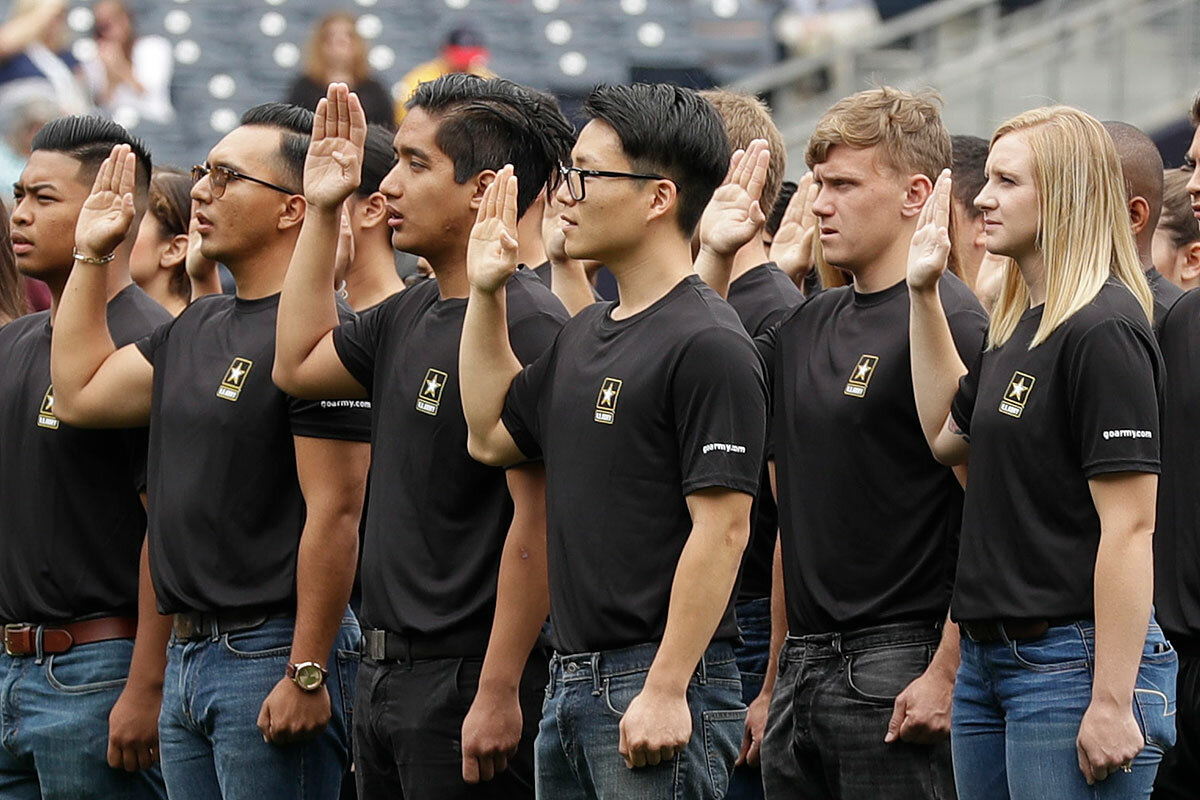Uncle Sam on Instagram: How Army adapts recruiting pitch for Gen Z
Loading...
| Vacaville, Calif.
Arleth Aguilar had mulled the idea of joining the military for several years by the time her half-brother enlisted in the Army earlier this spring. He sent her a link to his recruiter’s Instagram profile page, and there she saw the Army’s sales pitch delivered through memes featuring pugs, Rihanna, and Spider-Man.
The unexpected humor intrigued her enough to begin trading messages with the recruiter, Sgt. 1st Class Dario Franco. For Ms. Aguilar, who lacked phone service at the time, the ability to ask questions via the social media platform proved essential in helping her reach a decision. She signed up a few weeks ago and will report to basic training after graduating high school in June.
“Social media has a big impact on my life, and I think having that as a way of communication makes it a little more comfortable to talk to people,” Ms. Aguilar says. The informal tone of Mr. Franco’s Instagram posts “made me curious about being an insider of those jokes.”
Why We Wrote This
Long-running wars and low unemployment mean fewer young people enlisting in the military. So the Army has turned to big cities and social media, where its message of patriotism and service is finding new listeners.
Her enlistment story reflects the Army’s growing emphasis on social media as the service tries to court the digital natives of Generation Z and rebound from a recruiting deficit of 6,500 soldiers last year.
The expanded marketing campaign on Instagram, Facebook, Twitter, and other platforms attempts to appeal to a younger sensibility by infusing its message with humor – less Uncle Sam, more Will Ferrell – and touting what the Army has to offer beyond combat.
The shift away from traditional recruiting methods of television ads and phone calls occurs as the Army faces a steep climb toward this year’s goal of 68,000 new soldiers. In addition to recruiters posting memes and selfies, ads on social media and gaming platforms target digitally-savvy youth by promoting the Army’s array of tech and engineering jobs and its recently formed e-sports team.
“The military – the country – has been at war since 2001,” says Lisa Ferguson, a spokeswoman for the U.S. Army Recruiting Command based at Fort Knox in Kentucky. “So there are a lot of misperceptions about the Army. It’s not just infantry and busting down doors in Iraq. There are more than 150 career fields.”
An estimated 71 percent of Americans between 17 and 24 are ineligible to serve in the military for reasons that include obesity, mental health conditions, criminal offenses, and drug use. Meanwhile, a strong economy, with an unemployment rate below 4 percent, has siphoned off potential recruits.
The Army spent an extra $200 million on enlistment bonuses and eased admission standards last year in an effort to fulfill its recruiting quota. The service has bolstered its search for future soldiers this year by funneling more resources to almost two dozen big cities – ranging from San Francisco and Seattle to Boston and Philadelphia – located outside the historical recruiting strongholds of the South and Southeast.
“There’s something to be said for realizing there are qualified youth all over the country,” says Beth Asch, a senior economist with the RAND Corporation and an expert on military recruiting. “People in the U.S. are uninformed about what the military profession involves. If you’re not going into those cities to recruit, you’re going to have a harder time changing minds.”
A digital learning curve
Sergeant Franco works in an Army recruiting office that shares space in a strip mall with Jamba Juice and Cold Stone Creamery in Vacaville, California. The town lies at the fringes of the San Francisco Bay Area, about a half-hour’s drive from his hometown of Napa. Familiar surroundings aside, he felt off-balance after arriving here as a new recruiter three years ago.
He gained his bearings by relying on his experience as an intelligence analyst. In that role, Sergeant Franco, who deployed with the Army to Iraq and Afghanistan, collected and assessed data on known and potential threats in his unit’s areas of operation.
As a recruiter, he turned his analytical skills toward the region’s young adults, deciphering how to connect with them. A 2004 high school graduate who enlisted the next year, he recognized that tech’s rapid evolution required him to adopt strategies that differ from recruiting methods back then.
“Calling people was still something that was done when I signed up. But nobody has landlines anymore, and with caller ID, if they don’t know the number, they’re not answering,” he says. So instead of making cold calls for hours a day, when someone “likes” one of his Instagram posts, Sergeant Franco follows up with an invitation to contact him.
If the online exchanges lead to a conversation, he explains, “the rapport is smoother because there’s been a back-and-forth before we sit down to talk. If I meet someone for the first time at a high school or an event, it can be a little more awkward. Or they’ll just avoid me. If we’ve messaged on Instagram, their comfort level seems to be higher.”
The Army has scaled a digital learning curve over the past two years as top officials seek to increase the active-duty force from 476,000 soldiers to 500,000 by 2022. Once wary of social media, commanders now direct recruiters to post across platforms and engage their audiences, urging them to use humor and offer glimpses of their lives out of uniform.
“It’s important to show that it’s not all green, all the time,” says Lt. Col. Michael Firmin, who commands the Army’s Northern California recruiting battalion. Based outside Sacramento, the unit covers an area that extends into western Nevada and southern Oregon. “One thing we’ve realized is that young people don’t necessarily know that you’re not always in uniform. We want to make sure they understand it’s not Army, Army, Army all the time.”
Sergeant Franco’s Instagram page mixes memes that highlight the service’s education benefits and variety of career paths with photos of him hiking and playing with his two young sons. For all the focus the Army has placed on social media, he points out that his visits to high schools, career fairs, and community events yield far more recruits than his online posts.
But unlike public appearances, social media content lives forever. Both Ms. Aguilar and her half-brother, Steven Lopez, who shipped out for basic training earlier this month, spent time on Sergeant Franco’s Instagram page before contacting him. He has heard from some eventual recruits months after they first came across him online.
“Social media helps us get the message out there,” he says. “Then it keeps it out there until a person feels ready to take the next step.”
Belonging to a larger cause
The Air Force, Marine Corps, and Navy each reached its recruiting quota last year. The struggles of the Army, which requires more than twice as many enlistees, prodded top commanders to redouble recruiting efforts in 22 metro areas that the service long has treated as an afterthought.
The return on that investment will remain unknown until the Army announces its recruiting totals later in the year. Dr. Asch, with the RAND Corporation, regards the move as a worthwhile gambit as the Army seeks to reverse last year’s shortfall.
“These are cities with large populations of young people, and if you go in and inform them about the military, you could see the chances of recruiting them improve,” she says.
The stronger push into Los Angeles, Sacramento, and other cities coincides with a related strategy. “The military in general, and the Army in particular, is trying to tailor recruiting messages to specific geographic areas,” Dr. Asch says. “There has been a realization that the same message doesn’t necessarily work everywhere.”
Last fall in Chicago, the Army launched a recruiting pilot program with online ads aimed at young adults in neighborhoods across the city. Researchers found that ads describing the Army’s pay and health care benefits resonated with youth in working-class areas. Young residents in affluent neighborhoods, by contrast, responded to ads emphasizing leadership and travel opportunities.
Sergeant Franco has discerned differences in career interests across his recruiting territory. People who live in Napa gravitate toward the Army’s infantry and information technology positions. In Vacaville and nearby Dixon, where Ms. Aguilar attends school, they favor engineering and health care.
The diversity of careers within the service pops up as a recurring theme on Mr. Franco’s Instagram page. “People think the Army is only infantry and tanks,” he says. “But there are cooks, engineers, fuel specialists. So it’s a matter of educating people.”
At the same time, given the country’s long-running wars in Iraq and Afghanistan and the steady rotation of Army units to conflict zones around the world, recruits must accept the almost certain prospect of serving overseas irrespective of their position.
“The military is about fighting wars,” Dr. Asch says, “and when you join the military, you’re an asset who can be deployed. That said, there are a lot of occupations that contribute to the mission that aren’t infantry, and generally speaking, going overseas and doing your job – people want that.”
The sentiment holds true for Ms. Aguilar. She enlisted to obtain education benefits to pay for college in a few years. Before then, she wants to belong to a larger cause.
“I was told by many people that joining the military shouldn’t be an option, that I should pursue college,” she says. “But the thought of serving my country, helping people, and just giving back – that’s what grabs me the most.”







